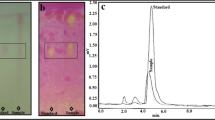Abstract
Acetylcholinesterase (AChE) and butyrylcholinesterase (BChE) inhibitors are used for the treatment of various disorders related to decline in acetylcholine levels in the brain by inhibiting the activity of the neurotransmitter AChE. The present study reports the potential of endophytic Alternaria spp. for their potential to produce cholinesterase inhibitors active against both acetylcholine and butyrylcholine. Twenty-nine isolates belonging to Alternaria spp. were isolated from different plants and screened. Variation with respect to inhibitor production was observed in different isolates. Out of 29 cultures screened, good cholinesterase (both AChE and BChE) inhibitory activity in range of 70–85% was observed in three isolates, whereas three showed only AChE inhibition. No correlation was observed in AChE and BChE inhibitor production. TLC bioautography for the inhibitor in the selected cultures evinced different Rf values of inhibitors indicating different nature of the compounds produced. In order to analyze evolutionary relationships between producer and non-producer strains, phylogenetic analysis of six producer and five non-producer strains was carried out using amplified ITS-I-5.8SrDNA-ITS-II region. Phylogenetic analysis revealed majority of the non-producer strains to be present on different clades indicating different evolutionary origins. The dual cholinesterase inhibitory activity and the diversity in the inhibitors produced by different isolates could prove to be novel sources of pharmaceutical as well as agriculturally important biomolecules after purification and characterization.
Similar content being viewed by others
Abbreviations
- AChE:
-
acetylcholinesterase
- BChE:
-
butyrylcholinesterase
References
Bartus R.T., Dean R.L. Beer B. & Lippa A.S. 1982. The cholinergic hypothesis of geriatric memory dysfunction. Science 30: 408–414.
Bhagat J., Kaur A., Sharma M., Saxena A.K. & Chadha B.S. 2011. Molecular and functional characterization of endophytic fungi from traditional medicinal plants. World J. Microbiol. Biotechnol. 28: 963–971.
Christias C.H., Hatzipapas P., Dara A., Kaliafas A. & Chrisanthis G. 2001. Alternaria alternata, a new pathotype pathogenic to aphids. Biocontrol 42: 105–124.
Darvesh S., Walsh R., Kumar R., Caines A., Roberts S., Magee D., Rockwood K. & Martin E. 2003. Inhibition of human cholinesterases by drugs used to treat Alzheimer disease. Alzheimer Dis. Assoc. Disord. 17: 117–126.
Eldeen I.M.S., Elgorashi E.E. & van Staden J. 2005. Antibacterial, anti-inflammatory, anticholinesterase and mutagenic effects of extracts obtained from some trees used in South African traditional medicine. J Ethnopharmacol. 102: 457–464.
Ellman G.L., Courtney K.D., Andres V. & Featherstone R.M. 1961. A new and rapid colorimetric determination of acetylcholinesterase activity. Biochem. Pharmacol. 7: 88–95.
Greig N.H., Utsuki T., Yu Q., Zhu X., Holloway H.W., Perry T., Lee B., Ingram D.K. & Lahiri D.K. 2001. A new therapeutic target in Alzheimer’s disease treatment: attention to butyrylcholinesterase. Curr. Med. Res. Opin. 17: 159–165.
Holden M. & Kelly C. 2002. Use of cholinesterase inhibitors in dementia. Adv. Psych. Treat. 8: 89–96.
Houghton P.J., Ren Y. & Howes M.J 2006. Acetylcholinesterase inhibitors from plants and fungi. Nat. Prod. Rep. 23: 181–199.
Kimura M. 1980. A simple method for estimating evolutionary rate of base substitutions through comparative studies of nucleotide sequences. J. Mol. Evol. 16: 111–120.
Larone D.H. 2002. Medically Important Fungi: A Guide to Identification. Washington, DC, ASM Press.
Martinez A. & Castro A. 2006. Novel cholinesterase inhibitors as future effective drugs for the treatment of Alzheimer’s disease. Expert Opin. Inv. Drugs. 15: 1–12.
McGleenon B.M., Dynan K.B. & Passmore A.P. 1999. Acetylcholinesterase inhibitors in Alzheimer’s disease. Br. J. Clin. Pharmacol. 48: 471–480.
Rhee I.K., Meent M.V., Ingkaninan K. & Verpoorte R. 2001. Screening for acetylcholinesterase inhibitors from Amaryllidaceae using silica gel thin-layer chromatography in combination with bioactivity staining. J. Chromatogr. A915: 217–223.
Rhee I.K., van Rijn R.M. & Verpoorte R. 2003. Qualitative determination of false-positive effects in the acetylcholinesterase assay using thin layer chromatography. Phytochem. Anal. 14: 127–131.
Rodrigues K.F., Costa G.L., Carvalho M.P. & Epifanio R.A. 2005. Evaluation of extracts produced by some tropical fungi as potential cholinesterase inhibitors. World J. Microbiol. Biotechnol. 21: 1617–1621.
Saitou N. & Nei M. 1987. The neighbor-joining method: a new method for reconstructing phylogenetic trees. Mol. Biol. Evol. 4: 406–425.
Shabana Y.M & Ragab M.E. 1997. Alternaria infectoria, a promising biological control agent for the fig wax scale, Ceroplastes rusci (Homoptera: Coccidae), in Egypt. Biocontrol. Sci. Technol. 7: 553–564.
Sharma M., Chadha B.S., Kaur M., Ghatora S.K. & Saini H.S. 2008. Molecular characterization of multiple xylanase producing thermophilic/thermotolearnt fungi isolated from composting materials. Lett. Appl. Microbiol. 46: 526–535.
Singh B., Thakur A., Kaur S., Chadha B.S. & Kaur A. 2012. Acetylcholinesterase inhibitory potential and insecticidal activity of an endophytic Alternaria sp. from Ricinus communis. Appl. Biochem. Biotechnol. 168: 991–1002.
Strobel G.A. 2003. Endophytes as sources of bioactive products. Microbes Infect. 5: 535–544.
Tamura K., Peterson D., Peterson N., Stecher G., Nei M. & Kumar S. 2011. MEGA5: molecular evolutionary genetics analysis using maximum likelihood, evolutionary distance, and maximum parsimony methods. Mol. Biol. Evol. 28: 2731–2739.
Tan R.X. & Zou W.X. 2001. Endophytes: a rich source of functional metabolites. Nat. Prod. Rep. 18: 448–459.
Zhang Z.B., Zeng Q.G., Yan R.M., Wang Y., Zou Z.R. & Zhu D. 2011. Endophytic fungus Cladosporium cladosporioides LF70 from Huperzia serrata produces Huperzine A. World J. Microbiol. Biotechnol. 27: 479–486.
Zhu D., Wang J., Zeng Q., Zhang Z. & Yan R. 2010. A novel endophytic Huperzine A-producing fungus, Shiraia sp. Slf14, isolated from Huperzia serrata. J. Appl. Microbiol. 109: 1479–1486.
Author information
Authors and Affiliations
Corresponding author
Rights and permissions
About this article
Cite this article
Singh, B., Bhagat, J., Chadha, B.S. et al. Cholinesterase inhibitory potential of different Alternaria spp. and their phylogenetic relationships. Biologia 69, 10–14 (2014). https://doi.org/10.2478/s11756-013-0294-z
Received:
Accepted:
Published:
Issue Date:
DOI: https://doi.org/10.2478/s11756-013-0294-z




